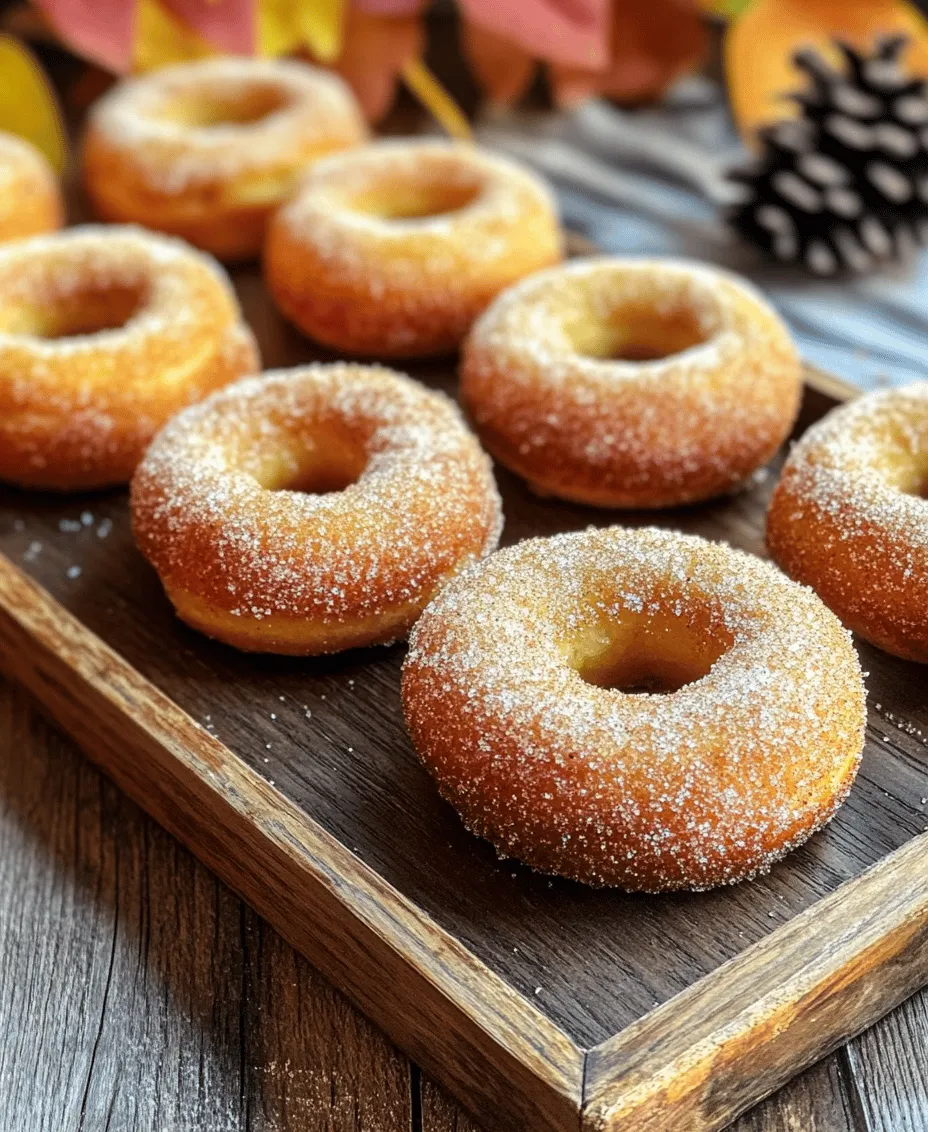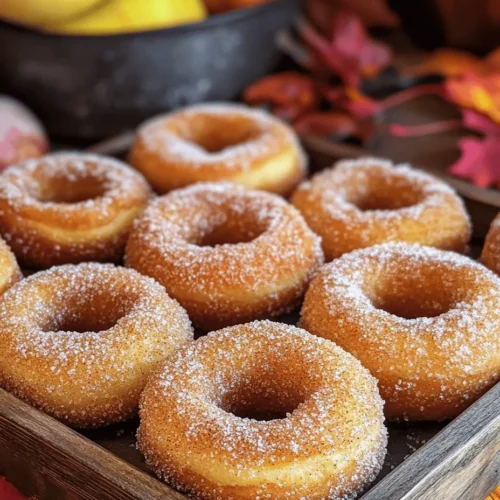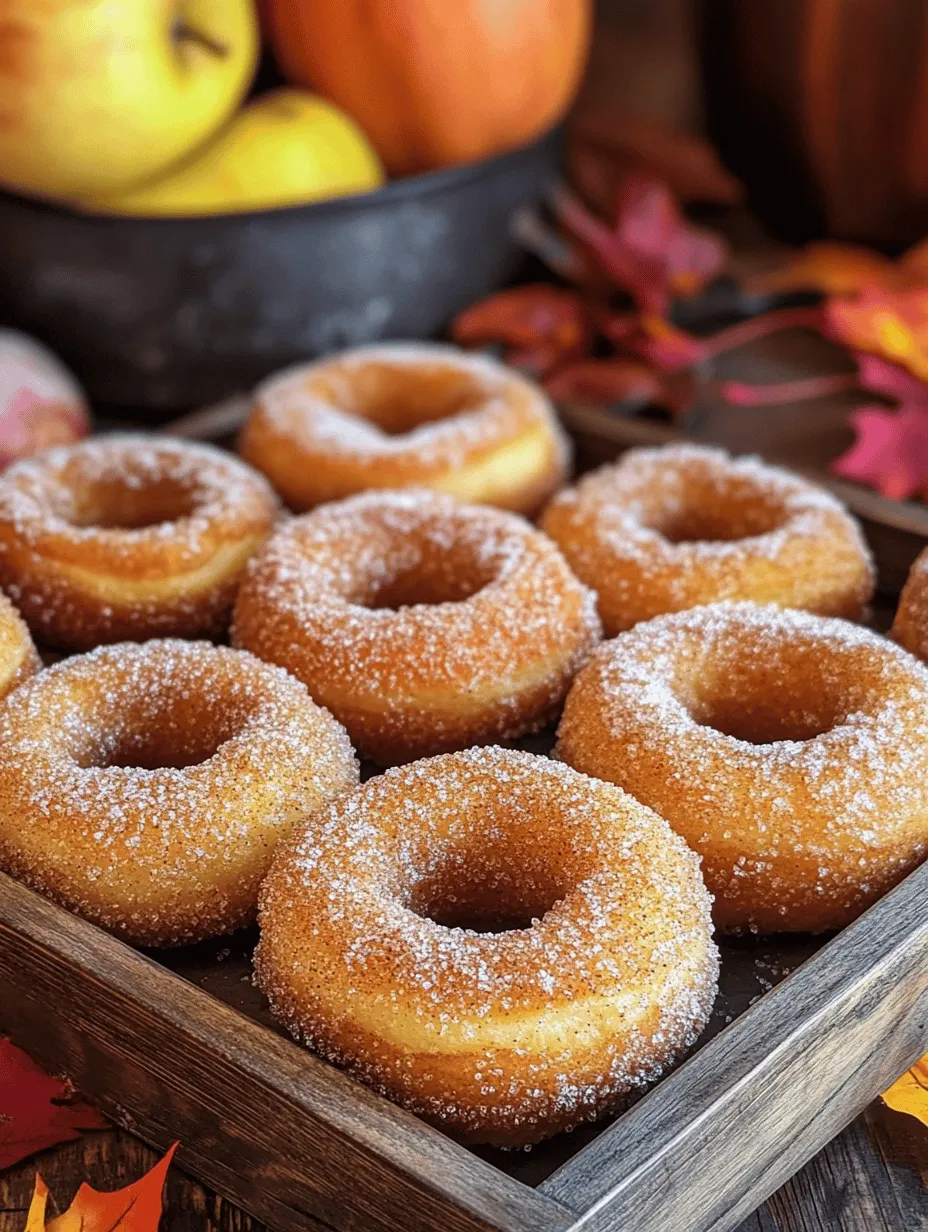Introduction
As the leaves begin to turn and the air grows crisp, nothing embodies the spirit of fall quite like a warm, homemade apple cider donut. These delightful treats are not only a seasonal favorite but have also become a beloved staple in many households during autumn. The enchanting aroma of cinnamon and nutmeg fills the kitchen, creating an atmosphere of comfort and nostalgia. Whether enjoyed with a steaming cup of coffee on a chilly morning or shared with friends and family at gatherings, apple cider donuts serve as a perfect reminder of the joys of the season.
This recipe for irresistible apple cider donuts offers a simple yet effective way to capture the essence of fall in your own kitchen. With just a few ingredients and straightforward steps, you can recreate this classic treat that evokes memories of trips to apple orchards and festive harvest celebrations. Dive into this guide as we explore the rich history and cultural significance of apple cider donuts, the essential ingredients that contribute to their delectable flavor, and the preparation steps that will lead you to baking perfection.
Understanding the Appeal of Apple Cider Donuts
Apple cider donuts have a rich history that traces back to the New England region, where apple picking and cider pressing have been cherished traditions for generations. These donuts emerged as a delicious way to utilize the apple cider produced during the harvest season, creating a unique treat that highlights the natural sweetness and flavor of fresh apples. The cultural significance of apple cider donuts is deeply intertwined with the traditions of autumn, making them a quintessential part of fall festivities.
Their popularity can be attributed to several factors. Firstly, the combination of spices like cinnamon and nutmeg, along with the sweetness of apple cider, creates a warm, comforting flavor profile that resonates with many. Secondly, the soft, cake-like texture of these donuts makes them incredibly satisfying to eat, while their slightly crisp exteriors provide an enticing contrast. Lastly, apple cider donuts have a charming versatility; they can be enjoyed plain, dusted with sugar, or even glazed for an extra touch of sweetness.
The act of making apple cider donuts can also serve as a wonderful family activity. Involving loved ones in the baking process fosters connection and creates lasting memories. Imagine the laughter and joy as you mix the ingredients, fill the donut pans, and watch the treats rise in the oven. Whether for a cozy family breakfast, a festive gathering, or simply to satisfy your sweet tooth, these donuts promise to bring warmth and happiness to any occasion.
Ingredients Breakdown
Essential Ingredients
The secret to crafting delicious apple cider donuts lies in the quality and combination of ingredients used. At the heart of this recipe is apple cider, which serves as the star ingredient. When reduced, apple cider concentrates its flavor and sweetness, infusing the donuts with that unmistakable essence of fall. It’s essential to use fresh, high-quality apple cider to achieve the best results.
Next, the choice of flour is crucial in determining the texture of the donuts. All-purpose flour is commonly used for its balanced protein content, resulting in a tender crumb. However, some bakers prefer to incorporate a bit of cake flour to enhance the lightness and softness of the finished product. Experimenting with different flour types can yield delightful results, so feel free to adjust according to your preferences.
Adding depth to the flavor profile are the warm spices—cinnamon and nutmeg. These spices not only enhance the taste but also evoke the comforting aromas associated with fall baking. Cinnamon, with its sweet and woody notes, pairs perfectly with the tartness of apples, while nutmeg adds a hint of warmth that rounds out the flavors beautifully.
Sweeteners
Achieving the perfect balance of sweetness is vital for apple cider donuts. In this recipe, both granulated sugar and brown sugar are utilized. Granulated sugar contributes a straightforward sweetness, while brown sugar adds a rich, caramel-like flavor due to its molasses content. This combination ensures that the donuts are not overly sweet but instead have a well-rounded flavor that complements the apple cider and spices.
Moreover, unsweetened applesauce plays a unique role in this recipe. Not only does it contribute moisture, which is crucial for a soft texture, but it also enhances the apple flavor without adding additional sweetness. This makes the donuts feel indulgent while keeping them somewhat lighter and healthier.
Wet Ingredients
The wet ingredients in this recipe are essential for achieving the desired consistency and flavor. The eggs provide structure and richness, helping the donuts rise and hold their shape while baking. Additionally, vanilla extract adds a warm, aromatic note that elevates the overall flavor of the donuts.
Melted butter is another critical component that contributes to the rich taste of the donuts. It not only adds flavor but also enhances moisture, ensuring that each bite is tender and satisfying. Using high-quality unsalted butter allows you to control the overall saltiness of the recipe, allowing the flavors of the apple cider and spices to shine.
Preparation Steps for Perfect Apple Cider Donuts
Reducing the Apple Cider
The initial step in preparing your apple cider donuts is to reduce the apple cider. This process involves simmering the cider over medium heat until it has thickened and concentrated in flavor. Start by pouring 2 cups of fresh apple cider into a saucepan and bringing it to a gentle boil. Once boiling, reduce the heat to low and allow it to simmer.
The reduction process typically takes about 15-20 minutes, but keep an eye on it to ensure it doesn’t burn. You’re aiming for a syrupy consistency that coats the back of a spoon. This step is crucial as it intensifies the natural sweetness and apple flavor, making your donuts truly irresistible.
To check if the cider has reduced enough, dip a spoon into the mixture; if it coats the back of the spoon and holds its shape, you’re ready to remove it from the heat. Allow the reduced cider to cool slightly before incorporating it into the batter, as adding hot liquid directly can affect the other ingredients.
Mixing Dry Ingredients
While the apple cider is reducing, you can prepare the dry ingredients. In a large mixing bowl, combine the all-purpose flour, baking powder, baking soda, cinnamon, nutmeg, and salt. Whisk these ingredients together thoroughly to ensure they are evenly distributed.
The leavening agents—baking powder and baking soda—are essential for achieving the perfect rise in your donuts. Baking powder provides the initial lift, while baking soda reacts with the acidity of the apple cider to create additional rise. The spices, as mentioned before, will infuse the donuts with that familiar fall flavor, and the salt will enhance all the other flavors in the mixture.
Once your dry ingredients are well combined, set them aside. This preparation allows for a smooth transition when you are ready to combine the wet and dry components, ensuring even mixing and a consistent batter.
—
This is just the beginning of your journey to creating irresistible apple cider donuts. The next steps will involve combining the wet and dry ingredients, pouring the batter into your donut pans, and, of course, the exciting moment when you pull your freshly baked treats from the oven. With each step, you’ll be one step closer to enjoying the warm, comforting flavors of fall right from your own kitchen. Stay tuned for the continuation of this delightful recipe!

Importance of Whisking to Ensure an Even Blend for Better Texture
Whisking is a crucial step in the process of creating irresistible apple cider donuts. Proper whisking ensures that all ingredients are evenly blended, which is essential for achieving a uniform texture. When combining your dry ingredients like flour, baking powder, and spices, a thorough whisking helps to aerate the mixture, preventing any clumps that could result in uneven donut texture. This not only improves the overall rise of the donuts but also ensures that every bite is as delightful as the last.
Incorporating a whisk rather than a spoon early on can make a significant difference, especially when mixing dry ingredients. A balloon whisk is particularly effective in this scenario as it allows for maximum air incorporation. For the wet ingredients, whisking helps emulsify the mixture, creating a smooth batter that will bake beautifully.
Combining Wet and Dry Ingredients
Once you have properly whisked your dry ingredients, it’s time to combine them with the wet ingredients. Start by creating a well in the center of the dry mix and pour in your wet ingredients, which typically include apple cider, eggs, and melted butter.
To achieve the right batter consistency, gently fold the wet ingredients into the dry mixture using a spatula. It’s important to avoid overmixing your batter. Overmixing can lead to the development of gluten, which can make your donuts tough rather than light and fluffy. A few lumps are perfectly acceptable; in fact, they can contribute to a tender texture.
Techniques for Achieving the Right Batter Consistency Without Overmixing
When folding the wet and dry ingredients, think of it as gently coaxing them together rather than aggressively stirring. Use a spatula to lift and fold the batter from the bottom of the bowl over the top. This method allows for better incorporation while keeping the gluten development at bay. Remember that lumps in the batter are not a bad thing; they can help to keep the donuts moist and tender.
If you notice that your batter is too thick, a tablespoon of additional apple cider can help loosen it up. However, make sure to add it gradually, as you want to avoid making the batter too runny. The ideal consistency is thick enough to hold its shape but soft enough to pipe easily into the donut pan.
Filling the Donut Pan
Now that your batter is ready, it’s time to fill the donut pan. You have two primary options for this process: using a piping bag or spooning the mixture directly into the pan.
Using a piping bag can be the cleaner and more efficient method, allowing for precise filling and reducing the mess typically associated with spooning. If you choose to use a piping bag, fill it with the donut batter and cut a small opening at the bottom. This will allow you to pipe the batter into the donut pan with ease.
If you prefer to spoon the batter, use a large spoon or an ice cream scoop to ensure even portions. To avoid overflow, fill each cavity of the donut pan about two-thirds full. This will give the donuts room to rise without spilling over the sides, which can lead to misshapen donuts.
Baking Process
Before placing your filled donut pan in the oven, make sure to preheat it to the temperature specified in your recipe, typically around 350°F (175°C). Preheating is essential as it ensures that your donuts begin baking at the right temperature, leading to an even rise and proper cooking time.
As the donuts bake, keep an eye on them. They usually take about 10-12 minutes to bake. Look for a slight golden color on the edges and a firm surface that springs back when lightly pressed. A toothpick inserted into the center should come out clean or with just a few crumbs attached. This is a good indication that your donuts are perfectly baked.
Cooling and Coating
Once baked, remove the donuts from the oven and let them cool in the pan for about 5 minutes. This cooling period is critical; it allows the donuts to firm up slightly, making them easier to remove without losing their shape. After that, transfer them to a wire rack to cool completely.
Coating your donuts in cinnamon-sugar is where the magic happens. For the coating, mix equal parts of granulated sugar and ground cinnamon in a shallow bowl. Once the donuts are cool enough to handle, gently roll them in the mixture. This step not only adds sweetness but also enhances the flavor profile, giving your donuts that classic fall taste.
Storage and Serving Suggestions
To maintain the freshness of your apple cider donuts, store them in an airtight container at room temperature. They are best enjoyed within a couple of days, but can be kept for up to a week if necessary. If you want to extend their shelf life, consider freezing them. Wrap each donut in plastic wrap and place them in a freezer-safe bag. They can be frozen for up to three months. To enjoy, simply thaw them at room temperature or pop them in the microwave for a few seconds.
When it comes to serving, apple cider donuts pair beautifully with a hot beverage. A cup of coffee or hot apple cider makes for a comforting combination, especially during crisp autumn days. For a more festive touch, consider garnishing the donuts with a drizzle of caramel sauce or a light glaze made from powdered sugar and apple cider.
Health Considerations and Modifications
While these apple cider donuts are a delightful treat, it’s essential to consider their nutritional content. Traditional recipes may contain refined sugar and all-purpose flour, which can be modified for a healthier version.
For a nutrient boost, you can substitute some or all of the all-purpose flour with whole wheat flour. This change adds fiber and can enhance the flavor profile. Additionally, reducing the amount of sugar by one-third or using a natural sweetener like maple syrup can help lower calories without sacrificing taste.
If you’re catering to dietary restrictions, there are various modifications you can make. For gluten-free options, consider using a gluten-free flour blend designed for baking. For those avoiding eggs, you can replace each egg with a quarter cup of unsweetened applesauce or a flaxseed meal mixture (1 tablespoon of ground flaxseed mixed with 2.5 tablespoons of water, allowed to sit for a few minutes until thickened).
Conclusion
Making irresistible apple cider donuts at home is not just about enjoying a delicious treat; it’s a celebration of the flavors and traditions associated with the fall season. The process of crafting these donuts brings joy and satisfaction, from the moment you gather your ingredients to the first bite of a warm, freshly baked donut.
Encourage your creativity by experimenting with spices, toppings, and even the dough itself. Each batch can reflect your unique tastes and preferences, making the recipe truly your own.
As you share these delightful donuts with family and friends, you strengthen the bonds of community and tradition that food so wonderfully fosters. Whether enjoyed at a cozy family gathering or a festive autumn celebration, these apple cider donuts are sure to become a cherished part of your seasonal traditions.



